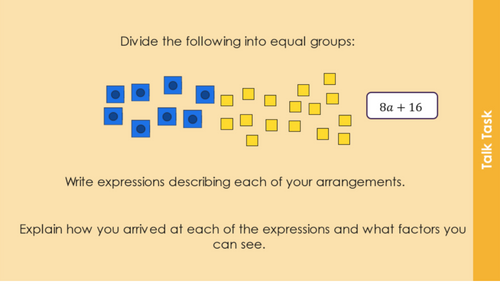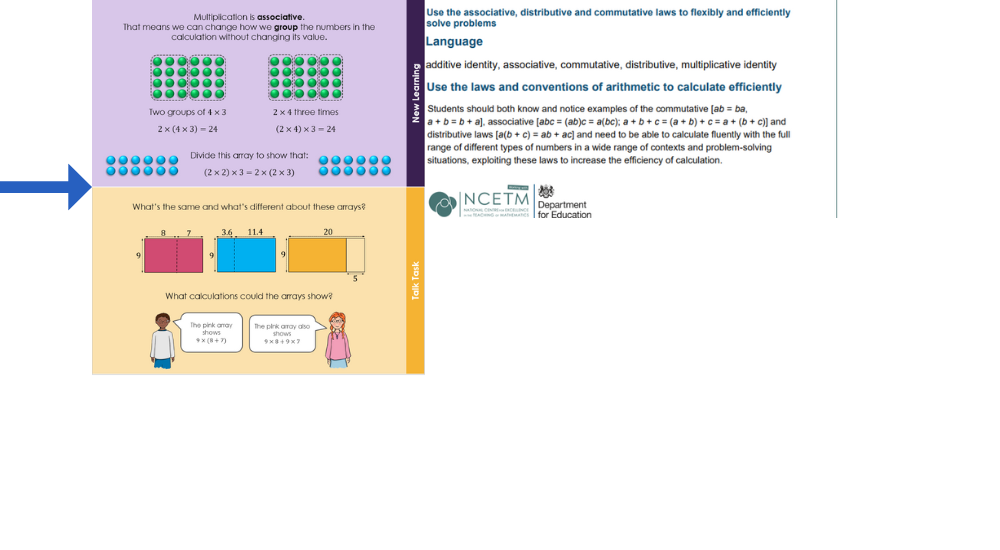
In both the updated (2022) Improving Mathematics in Key Stage 2 and 3 by the EEF and the 2021 Mathematics guidance: Key Stage 3 document by the DfE and NCETM, the focus of each document is on improving the quality of teaching through evidence based approaches. Both provide actionable guidance and in this short blog I share some examples of how to realise this with the support of Mathematics Mastery resources.
I was recently in a classroom where students were learning to factorise for the first time in Year 7. This is the original task from the unit
The teacher had used representations of multilink cubes on the board to demonstrate grouping and the students were trying to factorise 5x + 15 (answer 5 (x + 3) )
This particular group of LPA students could ‘see’ the ‘fiveness’ in the expression and wanted the teacher to make the first group like this. 

The teacher demonstrated the problem.

When he asked the students what they could do about this, one suggestion was simply to throw the remaining two x’s away!
Although the teacher did a great job of enacting the students’ ideas, I think (in fact I know!) that if the students had used hands on manipulatives themselves, they would have been able to negotiate this complex new learning and found those equal groups of x + 3 for themselves.
This rich exploration would, in turn lead to a deep and connected sense of grouping and what factorising means in a more abstract, algebraic context.
One of the reasons the students didn’t have access to manipulatives is because it’s difficult to do in a busy classroom..
It’s difficult for many reasons – here are a few for starters:
There’s a great body of evidence that shows the impact that using manipulatives has on students’ learning. It’s the second recommendation (after formatively assessing) in the EEF’s paper, Improving Mathematics in Key Stages 2 and 3. And you know what – I’d say it is formative assessment because we can literally see just what students are thinking, which is impossible to do if we simply model numerically.
The NCETM DfE KS3 Guidance on Teaching Key Stage 3 Maths also outlines the power of using representations in the classroom (‘representations’ are mentioned 167 times!) and explain that they will ‘aid students in deepening their understanding’.
Embedding these curriculum and pedagogical approaches is a challenge for subject leaders and classroom teachers. Identifying which parts of the curriculum would benefit from which representations, planning how to use them consistently, planning how to make links between topics in a coherent and cumulative ways – all this requires a lot of consideration and deliberate intent.
To be blunt – you probably don’t have time to turn all the suggestions included in the NCETM and EEF guidance into a reality.
At Mathematics Mastery Secondary, we work on these challenges full time – not only creating low threshold, high ceiling tasks that implement the principles of using manipulatives, but coherently embedding them in units so students access them over time.

In this example, students use manipulatives to think about the distributive property before moving onto the pictorial representation in the yellow slide. Arrays are used again and again in our curriculum because as research shows 'getting it' takes time (https://nrich.maths.org/8348)
Mathematics Mastery offers extensive Professional Development to support you every step of the way. As well as containing suggestions for ways to use representations, our lessons are prefaced with a Notes and Guidance slide which signpost the goals of the activities, misconceptions and teaching ideas. We also suggest activities for collaborative planning to help the whole team develop common approaches, and to share top tips and best practice among the team.
If you’d like to take a deep dive into how Mathematics Mastery Secondary aligns with the best practice advocated by the EEF in their improving Mathematics at KS2 and 3 guidance report and with the DfE guidance on Teaching mathematics at KS3, listen to me discuss this further in the recorded version of our most recent webinar.
For completeness the answer to the problem the teacher posed is
